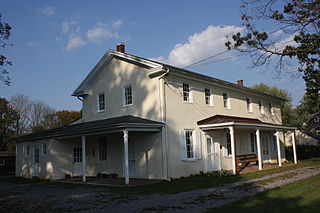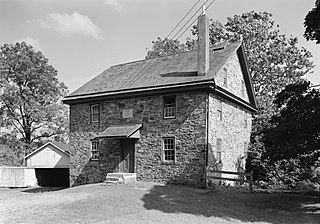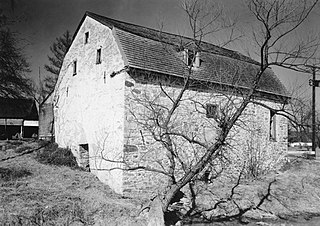
Makefield Meeting, also known as Makefield Monthly Meeting; Meeting House at Dolington, is a historic Quaker meeting house complex located in Upper Makefield Township, Bucks County, Pennsylvania. It was built in 1752 and the second story was added in 1764. It is a two-story, six bay, stuccoed stone structure with a gable roof. The building was renovated in 1851. The complex also includes the 2+1⁄2-story, stuccoed stone schoolmaster's house built in 1787, and a horse shed built about 1800.

Bangor Episcopal Church is a historic Episcopal church complex located at Churchtown, in Caernarvon Township, Lancaster County, Pennsylvania. The church was built in 1830, and is a 1 1/2-story, brownstone rectangular building in the Gothic Revival style. It has a steep, slate covered gable roof and steeple added about 1880. It features Gothic arch art glass windows. The complex includes the frame school building. It is a one-story, three bay building built in 1844 in the Greek Revival style. Also on the property is a contributing cemetery with approximately 325 graves dated from the Revolutionary War to the present.

Donegal Presbyterian Church Complex is a historic Presbyterian church complex on Donegal Springs Road in East Donegal Township, Lancaster County, Pennsylvania. The church was built in 1732, and is a 1 1/2-story, three bay by five bay, stuccoed stone building with a gambrel roof. The chapel underwent a remodeling in 1851. The adjacent cemetery is enclosed in a rough hewn stone wall built in 1791. The property also includes the William Kerr Study House, a 1 1/2-story, five bay brick dwelling originally built in 1810 and expanded in the early 20th century. The building was restored in 1976.
Union Bryarly's Mill is a historic flour and grist mill complex and national historic district located at Darkesville, Berkeley County, West Virginia. It encompasses four contributing buildings and two contributing sites. The buildings are the Bryarly Mill, Mansion House, log smokehouse and combination ice house building, log miller's house (1751), site of a distillery, and foundation containing archaeological remains. The mill was built about 1835, and is a two-story, three-bay brick building with a gable roof. The Mansion House was built about 1835, and is a two-story, L-shaped frame dwelling on a stone foundation.

Centre Mills is a historic grist mill located at Miles Township, Centre County, Pennsylvania. It was built in 1802-1803, and is a two-story fieldstone building, with a basement and attic. It measures 44 feet, 10 inches, by 58 feet, and has a gable roof. Also on the property are a barn, stone house, and miller's house. The stone house was built in 1813, and is a two-story stone dwelling, measuring 40 feet by 30 feet, with a two-story frame addition. It features a porch supported by Corinthian order columns. The miller's house is a frame dwelling on a stone foundation. The stone house is operated as a bed and breakfast.

Oregon Mill Complex, also known as Oregon Pike Mill & House; Oregon Mill-Twin Springs Farm, is a historic grist mill complex located in Oregon, Manheim Township, Lancaster County, Pennsylvania along Lititz Run. The mill was built in 1814, and is a two- to three-story, limestone structure. It is five bay by three bay, and has a gable roof. The mill was rebuilt in 1909. The former miller's house is a 2 1/2-story, stucco coated stone building with a hipped roof and in a conservative Italianate style. The limestone end barn was built between 1798 and 1815, and features a high-pitched gable roof.

Mascot Roller Mills, also known as Ressler's Mill, is a historic grist mill complex located at Upper Leacock Township, Lancaster County, Pennsylvania. The complex consists of the mill, miller's house, summer kitchen, and frame barn. The original section of the mill was built in 1737. The machinery was installed in 1906. It is a three-story, "L"-shaped stone building with a gable roof and cupola. The house was built in 1855, and is a two-story, gable roofed brick banked building. The summer kitchen is adjacent to the house is a one-story, brick structure. The small frame barn dates to the late-19th century. It is the oldest continuously operating grist mill in Lancaster County.

Kirks Mills Historic District is a national historic district located at Little Britain Township, Lancaster County, Pennsylvania. The district includes 12 contributing buildings in the village of Kirks Mills. They are Jacob Kirk's Mansion House, Brick Mill / Kirk's Mill, the brick miller's house, stone and log barn converted to a residence in 1975, Joseph Reynold's House (1825), Eastland Friend's Meeting and Tenant House, Ephriam B. Lynch House (1880s), Harry Reynolds House, Manuel Reynolds House, Eastland School House (1838), and Log House. The Jacob Kirk's Mansion House is a three-story, brick dwelling with a two-story ell. It features a full porch on the front and right sides. Kirk's Mill is a 2+1⁄2-story brick building with a slate gable roof. It was remodeled to a residence about 1940.

Rowland House, also known as the Shovel Shop, is a historic home located at Cheltenham Township, Montgomery County, Pennsylvania. It was built about 1774, expanded about 1810–1820, with additions built in the early 1900s and 1920s / 1930s. It is a 3+1⁄2-story, stuccoed stone building with a steep gable roof and one-story, frame addition.

Miller's House at Spring Mill is a historic building in the Spring Mill section of Whitemarsh, Montgomery County, Pennsylvania, United States. Located about 200 feet from where Spring Mill Creek empties into the Schuylkill River, it is about a quarter-mile southeast of the Borough of Conshohocken.

The Swatara Furnace is a historic iron furnace and 200-acre national historic district located along Mill Creek, a tributary of the Swatara Creek in Pine Grove Township, Schuylkill County, Pennsylvania.

Sally Ann Furnace Complex is a historic iron furnace complex site located at Rockland Township, Berks County, Pennsylvania. It includes the remains of furnace, barns, stable, storage sheds, grist mill, and bake ovens. The furnace was built in 1791 along Sacony Creek and once stood 32 feet high. Adjacent to the mill is a 1 1/2-story stone dwelling built in 1798. In 1814, a 2 1/2-story rectangular, stuccoed stone mansion house was added. It is five bays by two bays, and has a gable roof with dormers. Also on the property is a 1 1/2-story, stone company store and storekeeper's residence, and 2 1/2-story stuccoed stone granary.

Willow Mill Complex is a complex of historic buildings located at Richboro, Northampton Township, Bucks County, Pennsylvania. The complex consists of the Shaw-Leedom House and spring house / smoke house and the Howard Sager House, wagon house, and grist mill. The Shaw-Leedom House was built about 1800, and is a 2+1⁄2-story, five bay, stone dwelling with a gable roof in the Federal style. It has a 1+1⁄2-story, two-bay stone wing believed to be the kitchen wing from an earlier house. The adjacent stone spring / smoke house was also built about 1800. The Willow Mill was built in the 1840s, and is a four-story stone building converted to residential use in 1938. The Sager House was built in 1847, and is a 2+1⁄2-story, three bay, ashlar stone building. It has a gable roof with dormers and shed roof "Dutch Stoop" kitchen wing. Associated with it is a two-story, frame wagon house dated to the 19th century.

Spring Mill Complex, also known as the Michael Gunkle Spring Mill, is a historic grist mill complex located in East Whiteland Township, Chester County, Pennsylvania. The mill was built in 1793, and is a 2+1⁄2-story, banked stone structure with a gable roof. Also on the property are the contributing 2+1⁄2-story, stuccoed stone miller's house; a 1-story, stone spring house; a 1-story, stone smoke house; and a 1-story, stone carriage house. The mill remained in continuous operation into the 1940s.

Squire Cheyney Farm is a historic farm and national historic district located in Thornbury Township, Chester County, Pennsylvania. The district encompasses two contributing buildings, three contributing sites, one contributing structure, and contributing object. They are the farmhouse, barn, ruins of a granary, remains of an ice house, a spring house (1799), stone retaining wall, and family cemetery. The house was built in four periods, with the oldest dated to about 1797. The oldest section is a 2 1/s-story, three bay, stuccoed stone structure with a gable roof. The additions were built about 1815, about 1830, and about 1850, making it a seven-bay-wide dwelling. It is "L"-shaped and has a slate gable roof. During the American Revolution, Thomas "Squire" Cheyney [II] informed General George Washington during the Battle of Brandywine that the British were flanking him to the north. He was later appointed to the Pennsylvania Ratifying Convention to ratify the United States Constitution. The site is now a township park known as Squire Cheyney Farm Park.

Roger Hunt Mill is a historic grist mill complex located at Downingtown, Chester County, Pennsylvania. The mill was built in 1759, and is a two-story, stone structure with a gambrel roof measuring 30 feet, 6 inches, by 48 feet. It has a one-story frame addition. The main house was built about 1740 and is a two-story, five-bay, stone structure with Georgian design details. The house has a 2+1⁄2-story, stone extension built about 1850. Other contributing buildings are the 2-story, Queen Anne-style carriage house; 2+1⁄2-story, Greek Revival style tenant house ; and 1+1⁄2-story stone miller's house.

Hockley Mill Farm, also known as Mt. Pleasant Mills and Frank Knauer Mill, is a historic home and grist mill located in Warwick Township, Chester County, Pennsylvania. The farm has three contributing buildings and one contributing structure. They are the miller's house, 1+1⁄2-story stone-and-frame grist mill (1805), stone-and-frame bank barn, and the head and tail races. The house is a 2+1⁄2-story, five-bay, banked fieldstone dwelling with a gable roof. The foundation in the western section was built about 1725 to support a log dwelling. It was expanded with the present eastern section in 1735, and the log section replaced about 1780. A two-story, two-bay annex was built in 1935–40, and expanded in 1965. A shed-roofed addition was built to the north in 1990.

Clinger-Moses Mill Complex, also known as Clement's Mill, is a historic mill complex located in West Pikeland Township, Chester County, Pennsylvania. The property includes the site of two mills, a stone dam, a mill house, stone bank barn, and outbuildings. A former three-story grist mill built in 1860 has been converted to residential use. There is a four-story, three bay by three bay, fieldstone mill building. A five-bay, frame house has been built on the foundations of a former saw mill. The main house was built in 1801, and is a 2 1/2-story, fieldstone dwelling with a gable roof and two-story rear wing.

Blenheim is a historic home and farm complex located at Blenheim, Albemarle County, Virginia. The once very large surrounding plantation was established by John Carter. Late in the 18th century, his son Edward Carter became the county's largest landowner, and in addition to public duties including service in the Virginia General Assembly built a mansion on this plantation where he and his family resided mostly in summers, but which was destroyed by fire and sold by auction circa 1840.

The Homeplace is a historic home and farm complex located at Madison, Madison County, Virginia. The original house was built about 1830, and is a gable-roofed hall-and- parlor building with a rear shed addition, built of frame over a stone basement. It was extensively enlarged about 1875 by the addition of a two-story wing built on an I-house plan. Also on the property are the contributing barn, well house, sun pit (greenhouse), bunkhouse for farm workers, meathouse, and a building which once housed the furniture factory operated by the Clore family.
























